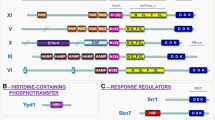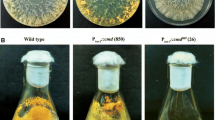Abstract
A gene for a putative two-component histidine kinase, which is homologous to os-1 from Neurospora crassa, was cloned and sequenced from the plant-pathogenic fungus Cochliobolus heterostrophus. The predicted protein possessed the conserved histidine kinase domain, the response regulator domain, and six tandem repeats of 92-amino-acids at the N-terminal end that are found in histidine kinases from other filamentous fungi. Introduction of the histidine kinase gene complemented the deficiency of the C. heterostrophus dic1 mutant, suggesting that the Dic1 gene product is a histidine kinase. Dic1 mutants are resistant to dicarboximide and phenylpyrrole fungicides, and they are sensitive to osmotic stress. We previously classified dic1 alleles into three types, based on their phenotypes. To explain the phenotypic differences among the dic1 mutant alleles, we cloned and sequenced the mutant dic1 genes and compared their sequences with that of the wild-type strain. Null mutants for Dic1, and mutants with a deletion or point mutation in the N-terminal repeat region, were highly sensitive to osmotic stress and highly resistant to both fungicides. A single amino acid change within the kinase domain or the regulator domain altered the sensitivity to osmotic stress and conferred moderate resistance to the fungicides. These results suggest that this predicted protein, especially its repeat region, has an important function in osmotic adaptation and fungicide resistance.



Similar content being viewed by others
References
Alex LA, Simon MI (1994) Protein histidine kinases and signal transduction in prokaryotes and eukaryotes. Trends Genet 10:133–138
Alex LA, Borkovich KA, Simon MI (1996) Hyphal development in Neurospora crassa: involvement of a two-component histidine kinase. Proc Natl Acad Sci USA 93:3416–3421
Alex LA, Korch C, Selitrennikoff CP, Simon MI (1998) COS1, a two-component histidine that is involved in hyphal development in the opportunistic pathogen Candida albicans. Proc Natl Acad Sci USA 95:7069–7073
Bourret RB, Borkovich KA, Simon MI (1991) Signal transduction pathways involving protein phosphorylation in prokaryotes. Annu Rev Biochem 60:401–441
Calera JA, Choi GH, Calderone R (1998) Identification of a putative histidine kinase two-component phosphorelay gene (CaHK1) in Candida albicans. Yeast 14:665–674
Chang C, Kwok SF, Bleecker AB, Meyerowitz EM (1993) Arabidopsis ethylene-response gene ETR1: similarity of product to two-component regulators. Science 262:539–544
Cui W, Beever RE, Parkes SL, Weeds PL, Templeton MD (2002) An osmosensing histidine kinase mediates dicarboximide fungicide resistance in Botryotinia fuckeliana (Botrytis cinerea). Fungal Genet Biol 36:187–198
Edlich W, Lyr H (1995). Mechanism of action of dicarboximide fungicides. In: Lyr H (ed) Modern selective fungicides: properties, applications, mechanisms of action. Gustav Fischer, New York, pp 119–131
Fassler JS, Gray WM, Malone CL, Tao W, Lin H, Deschenes RJ (1997) Activated alleles of yeast SLN1 increase Mcm1-dependent reporter gene expression and diminish signaling through the Hog1 osmosensing pathway. J Biol Chem 272:13365–13371
Faretra F, Pollastro S (1991) Genetic basis of resistance to benzimidazole and dicarboximide fungicides in Botryotinia fuckeliana (Botrytis cinerea). Mycol Res 95:943–951
Faretra F, Pollastro S (1993) Isolation, characterization and genetic analysis of laboratory mutants of Botryotinia fuckeliana resistant to the phenylpyrrole fungicide CGA173506. Mycol Res 97:620–624
Fujimura M, Ochiai N, Ichiishi A, Usami R, Horikoshi K, Yamaguchi I (2000a) Fungicide resistance and osmotic stress sensitivity in os mutants of Neurospora crassa. Pestic Biochem Physiol 67:125–133
Fujimura M, Ochiai N, Ichiishi A, Usami R, Horikoshi K, Yamaguchi I (2000b) Sensitivity to phenylpyrrole fungicides and abnormal glycerol accumulation in os and cut mutant strains of Neurospora crassa. J Pestic Sci 25:31–36
Gustin MC, Albertyn J, Alexander M, Davenport K (1998) MAP kinase pathways in the yeast Saccharomyces cerevisiae. Microbiol Mol Biol Rev 62:1264–1300
Kieber JJ, Rothenberg M, Roman G, Feldman KA, Ecker JR (1993) CTR1, a negative regulator of the ethylene response pathway in Arabidopsis, encodes a member of the Raf family of protein kinases. Cell 72:427–441
Maeda T, Wurgler-Murphy SM, Saito H (1994) A two-component system that regulates an osmosensing MAP kinase cascade in yeast. Nature 369:242–245
Millar TK, Renault S, Selitrennikoff CP (2002) Molecular dissection of alleles of the osmotic-1 locus of Neurospora crassa. Fungal Genet Biol 35:147–155
Nagahashi S, Mio T, Ono N, Yamada-Okabe T, Arisawa M, Bussey H, Yamada-Okabe H (1998) Isolation of CaSLN1 and CaNIK1, the genes for osmosensing histidine kinase homologues, from pathogenic fungus Candida albicans. Microbiology 144:425–432
Nakada M, Tanaka C, Tsunewaki K, Tsuda M (1994) RFLP analysis for species separation in genera Bipolaris and Curvularia. Mycoscience 35:271–278
Ochiai N, Fujimura M, Motoyama T, Ichiishi A, Usami R, Horikoshi K, Yamaguchi I (2001) Characterization of mutants in the two-component histidine kinase gene that confer fludioxonil resistance and osmotic sensitivity in the os-1 mutants of Neurospora crassa. Pest Manag Sci 57:437–442
Oshima M, Fujimura M, Banno S, Hashimoto C, Motoyama T, Ichiishi A, Yamaguchi I (2002) A point mutation in the two-component histidine kinase BcOS1 gene confers dicarboximide resistance in field isolates of Botrytis cinerea. Phytopathology 92:75–80
Ota IM, Varshavsky A (1993) A yeast protein similar to a bacterial two-component regulator. Science 262:566–569
Parkinson JS, Kofoid EC (1992) Communication modules in bacterial signaling proteins. Annu Rev Genet 26:71–112
Pommer EH, Lorenz G (1995) Dicarboximide fungicides. In: Lyr H (ed) Modern selective fungicides: properties, applications, mechanisms of action. Gustav Fischer, New York, pp 99–118
Schumacher MM, Enderlin CS, Selitrennikoff CP (1997) The osmotic-1 locus of Neurospora crassa encodes a putative histidine kinase similar to osmosensors of bacteria and yeast. Curr Microbiol 34:340–347
Shimizu K, Tanaka C, Tsuda M (1997) Cloning of Brn1, a reductase gene involved in melanin biosynthesis in Cochliobolus heterostrophus. J Gen Appl Microbiol 43:145–450
Stock AM, Robinson VL, Gaudreau PN (2000) Two-component signal transduction. Annu Rev Biochem 69:183–215
Takano Y, Kubo Y, Shimizu K, Mise K, Okuno T, Furusawa I (1995) Structural analysis of PKS1, a polyketide synthase gene involved in melanin biosynthesis in Colletotrichum lagenarium. Mol Gen Genet 249:162–167
Tanaka C, Nakada M, Tsuda M (1992) Electrophoretic separation of chromosomes of some graminicolous fungi. Trans Mycol Soc Jpn 33:95–102
Yamada-Okabe T, Mio T, Ono N, Kashima Y, Matsui M, Arisawa M, Yamada-Okabe H (1999) Roles of three histidine kinase genes in hyphal development and virulence of pathogenic fungus Candida albicans. J Bacteriol 181:7243–7247
Yoshimi A, Imanishi J, Gafur A, Tanaka C, Tsuda M (2003) Characterization and genetic analysis of laboratory mutants of Cochliobolus heterostrophus resistant to dicarboximide and phenylpyrrole fungicides. J Gen Plant Pathol 69:101–108
Zhang Y, Lamm R, Pillonel C, Lam S, Xu J-R (2002) Osmoregulation and fungicide resistance: the Neurospora crassa os-2 gene encodes a HOG1 mitogen-activated protein kinase homologue. Appl Environ Microbiol 68:532–538
Author information
Authors and Affiliations
Corresponding author
Additional information
Communicated by C. A. M. J. J. van den Hondel
Rights and permissions
About this article
Cite this article
Yoshimi, A., Tsuda, M. & Tanaka, C. Cloning and characterization of the histidine kinase gene Dic1 from Cochliobolus heterostrophus that confers dicarboximide resistance and osmotic adaptation. Mol Genet Genomics 271, 228–236 (2004). https://doi.org/10.1007/s00438-003-0974-4
Received:
Accepted:
Published:
Issue Date:
DOI: https://doi.org/10.1007/s00438-003-0974-4




